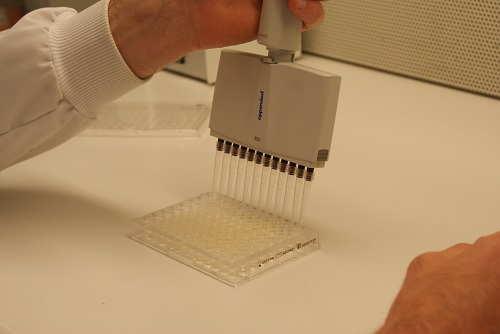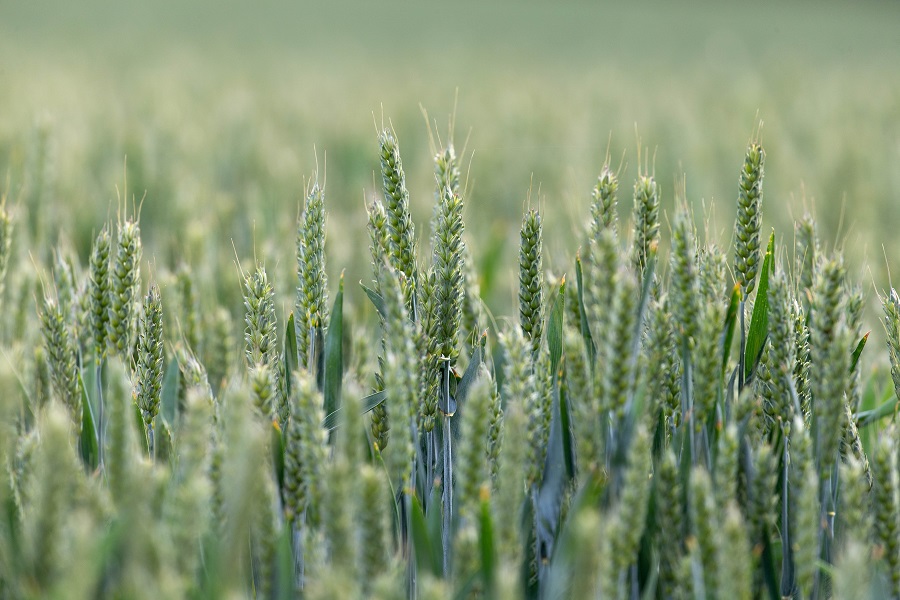There’s a new biostimulant on the market that does quite a different job from the rest. CPM explores the science behind it.
No other biostimulant mimics what this does.
By Tom Allen-Stevens
In a very crowded market of new biostimulants, there’s one available this year that’s set to stand out. YieldOn is a combination of plant extracts with micronutrients applied relatively late in the season designed to transfer plant assimilates and sugars from the leaf and stem into the grain – put the yield on. And apparently it does.
“We’re really rather excited about YieldOn,” says Hutchinsons’ technical manager Dick Neale. “It’s a biostimulant that’s more often than not given us a significant yield response in small-plot trials – that’s rare.”

Valagro scientists applied new techniques to the study of plant extracts.
Dr Mark Glover looks after the biological, adjuvant and micronutrient portfolio at Agrii. “We’re still learning with biostimulants, and they’re no magic bullet. But in 2018, a year when a lot of products appeared to perform in trials, YieldOn was one that did so significantly.”
YieldOn is a new combination of three different plant extracts, including seaweed, designed specifically to “switch on” yield explains Valagro UK technical and sales manager Mike Garner.
“Valagro’s UK business (formerly Maxicrop) had been involved with biostimulants and crop nutrition from plant extracts for many years before it was acquired in 2002. What Valagro has done is put these extracts through its GeaPower research platform to exploit the action potential of the plant biostimulants (see panel on pxx).
“This applied new scientific techniques to the study of plant extracts, both to understand what they do at a genomic level and how that translates into in-field behaviour.”
The scientists came to a new combination of plant extracts which they enriched with manganese, zinc and molybdenum. Through next generation sequencing of plants treated with the new product they identified 949 differentially expressed genes for corn and 134 for soybean – this is where a gene had been upregulated (switched on) as a result of the prototype product, explains Shane Deaville, Valagro country manager for UK and Ireland.
“The research team narrowed it down to the most significant gene responses. What they found is that it had distinct effects on corn and soybean plants at a molecular level.” It could increase plant productivity through:
- Better transport of sugars and nutrients
- Promotion of cell division
- Fatty acids biosynthesis and transport (observed in soybeans).
“There was a strong effect on genes that influenced the loading of the phloem cells – the ones that transport sugar and assimilates through the plant. Here the scientists found some genes were up-regulated as much as 27-30 times through the activity of the new product.”
So this was YieldOn. Not only was it causing better transportation of sugars and nutrients around the plant, it was increasing phosphate efficiency. The increased cell division had the effect of generating more, larger seeds. Trials carried out across the world confirmed the responses in a number of key crops. “We looked at these initial results and thought, ‘Wow! What about wheat in the UK?’” notes Shane.
Trials started in 2018, and after initial discussions with key distributors, wheat was chosen as the focus crop. “What’s interesting about YieldOn is that it’s not like other biostimulants – it’s not a stress reliever. It’s applied at the T2 spray timing after the crop has built its biomass, to help it transfer this into the grain,” explains Mike.
Following good results in 2018 (see table on pxx), Shane and Mike expanded the UK trials for 2019 into oilseed rape. “The ideal timing is mid-flowering, but it can be applied at early or late flowering to tie in with a fungicide spray – what we’ve found with YieldOn is that it’s very compatible with a wide range of products.”
Similarly strong results were achieved through Valagro’s OSR trials, and these were repeated in 2020, this time with spring barley included. “We now have a recommendation for 2 l/ha applied at the T2 timing for both winter wheat and spring barley, and the same rate in OSR,” notes Mike.
“YieldOn helps partitioning in the plant, leading to greater grain numbers and size. This year, we’re also looking at maize – there have been good results achieved in France.”
In Hutchinsons trials, Dick Neale has been finding four out of five plots are showing a significant response. “The average result is 0.49t/ha, but we have seen responses as high as 0.7t/ha. In OSR the yield benefit is around 0.3t/ha,” he reports.
“The difference here is that YieldOn isn’t a product for that crowded GS 30/31 timing where most biostimulants are focused. This is GS 39-60. It’s doing a specific job, and what I like about it is that it’s less dependent on soil conditions. The crop has taken up and accumulated its yield potential – it doesn’t really matter whether that’s been through plying it with nitrogen or through organic sources. This is about transferring the sugars and nutrients the crop already has into the grain.
“Of course, the weather has to give it the opportunity to complete that process, but YieldOn appears to help – no other biostimulant mimics what this does,” notes Dick.
For Agrii, biostimulants form a key part of the company’s activity under its Green Horizons sustainability initiative, backed with an extensive trials programme. “Getting a clear picture on how to use biostimulants is difficult, and they are not the answer to all your woes,” says Mark Glover.
“But YieldOn did give us a consistent, significant yield benefit in 2018 averaging 0.5t/ha in winter wheat. We have seen positive trends in subsequent years, although none have been statistically significant.
“What sparked interest for us is that it increases nutrient use efficiency, such as for phosphate and nitrogen. I don’t think you’ll notice a difference in a high-yielding situation, nor where a crop is really struggling at the end of the season. But it does bring the opportunity to preserve that potential, particularly as we’re losing plant protection products.”
In field-scale, tramline trials, Dick’s seen positive responses, although these weren’t taken over a weighbridge. Mark advises this may be the best route for growers to try out YieldOn for themselves. “I’d encourage farmers to do a tramline trial this harvest, especially if you can measure the result over a weighbridge. There’s still a lot to learn on biostimulants, so the more trials in different situations, the better.”
Putting science into biostimulants
YieldOn is the first product available in the UK that has utilised Valagro’s GeaPower research platform to identify raw materials of interest, understand what they do to plants and formulate the product:
- Extraction and understanding – years of experience with the raw materials have refined both the best method to separate out the active components and the knowledge on their biological and chemical characteristics.
- Cutting-edge analytics – genomics, proteomics and metabolomics are used to decipher the genetic and molecular triggers and obtain specific physiological responses in plant systems (see below).
- Selection and formulation – once a thorough understanding of the active ingredients and their pathways has been established, the extraction methods are refined and a solution that delivers the desired outcome is developed.

YieldOn performance in trials

Innovation Insight
CPM would like to thank Valagro for kindly sponsoring this article, and for providing privileged access to staff and material used to help put the article together.




